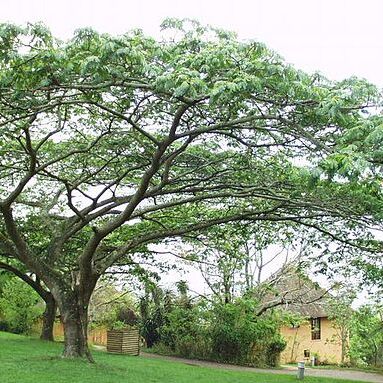Tree 4–30 m. high; crown flattened; bark grey to yellowish-brown and rough (rarely smooth in our area).. Young branchlets densely, rather coarsely and persistently rusty-to fulvous-pubescent.. Leaves: pinnae 5–8 pairs (rarely only 3 on occasional reduced leaves), each pinna more or less narrowing upwards; leaflets of 2 distal pairs of pinnae 9–17 pairs, obliquely rhombic-quadrate or-oblong, mostly about 7–17(–20) mm. long and 4–9(–11) mm. wide; proximal margin at base usually more or less rounded into the pulvinus but not auriculate; apex of leaflet usually obtuse and mucronate, sometimes subacute, surface of leaflet thinly pubescent above, rather plentifully pubescent all over beneath, raised venation beneath close.. Stipules and bracts at base of peduncles ovate, about 5–12 mm. long and 3–6(–8) mm. wide.. Peduncles clothed as the young branchlets; bracteoles variably persistent, linear-spathulate to oblanceolate, 5–8 mm. long, exceeding the flower-buds.. Flowers subsessile; pedicels pubescent, 0.5–1 mm. long.. Calyx 2.5–4 (rarely only 2) mm. long, pubescent outside.. Corolla 6–11 mm. long, pubescent outside, white or greenish-white.. Staminal tube exserted about 1.3–2 cm. beyond corolla, red to wholly greenish or pink.. Pod oblong, flat or slightly transversely plicate, 9–19 cm. long, 1.9–3.2 (–? 4) cm. wide, more or less densely and persistently pubescent, not glossy, prominently venose, usually pale brown.. Seeds 7–9.5 mm. long, 6.5–8.5 mm. wide, flattened.. Figs. 21/6–9, p. 159, & 22/2, p. 163.
Leaves: pinnae 5-8 pairs (rarely only 3 on occasional reduced leaves), each pinna ± narrowing upwards; leaflets of 2 distal pairs of pinnae (8)9-17 pairs, mostly c. 7-17(24) x 4-9(15) mm., obliquely rhombic-quadrate or-oblong; proximal margin at base usually ± rounded into the pulvinus but not auriculate; apex of leaflet usually obtuse and mucronate, sometimes subacute, surface of leaflet thinly pubescent above, rather plentifully pubescent all over beneath, raised venation beneath close.
A very large tree. It grows to 40 m high. It is often smaller. It has a flat crown. The bark is grey to yellow-brown. The leaves are compound. They have 4-7 pairs of leaf stalks and each one has 6-12 pairs of leaflets. The leaflets have a rectangular shape. They are 2 cm long by 0.5-0.8 cm wide. They are dark green with yellow hairs below. The flowers are half round heads. There are few flowers in a head so it is lax. The fruit is a brown flattened pod. These are 12.5 cm long.
Tree (2·5)4-30 m. high; crown flattened; bark grey to yellowish-brown and rough (rarely smooth in our area); young branchlets densely rather coarsely and persistently rusty-to fulvous-pubescent; pubescence sometimes becoming grey as the branchlet ages.
Tree, up to 20 m high. Young branchlets densely and persistently rusty-to fulvous-pubescent. Leaflets 4-8 (-11) mm wide, obliquely rhombic-quadrate or-oblong, midrib diagonal. Flowers white.
Pod dehiscent, 9-19 x 1·9-3·4(4·3) cm., usually pale brown, oblong, flat or slightly transversely plicate, ± densely and persistently pubescent, not glossy, prominently venose.
Peduncles clothed as the young branchlets; bracteoles variably persistent, 5-8 mm. long, exceeding the flower-buds, linear-spathulate to oblanceolate.
Staminal tube exserted c. 1·3-2.5 cm. beyond the corolla, red to wholly greenish or pink.
Stipules and bracts at base of peduncles c. 5-12 x 3-6(8) mm., ovate.
Corolla 6-11 mm. long, white or greenish-white, pubescent outside.
Flowers subsessile; pedicels pubescent, 0·5-1(2) mm. long.
Calyx 2·5-5 (rarely only 2) mm. long, pubescent outside.
A tree, to 120 ft. high, mainly in regrowth forest
Flowers greenish-white with reddish staminal tube.
Seeds 7-9·5 x 6·5-8·5 mm., flattened.


